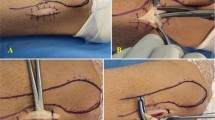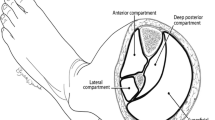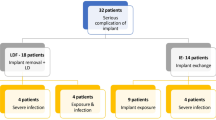Abstract
Purpose
This study assesses the anatomical features of the cutaneous fibular perforators and perforasomes of fibular free flap to determine the clinical implications therein.
Methods
This anatomical study was performed with 16 fresh cadavers after selective arterial injections of inked serum. The numbers of perforators, diameter, location of the perforasome center, perforator course, the distance between perforator origin and tibiofibular division, and the perforasome area were all documented.
Results
Thirty-one lower legs were dissected. Eighty-eight cutaneous perforators were found, averaging 2.8 per leg (1–4). The mean diameter was 1.7 mm and decreased from proximal to distal (p < 0.001). The centers of the perforasomes were aligned on an oblique projection from proximal to distal and anterior to posterior. Seventeen perforators (19%) were musculocutaneous, all in the proximal half of the leg, whereas 71 perforators were septocutaneous (81%), including 18 in the proximal half of the leg. Six of the uppermost perforators originated from the fibular artery less than 10 mm from the tibiofibular division. The mean area perforasome was 37.2 cm2 (7.9–106 cm2) and decreased from proximal to distal (p < 0.01).
Conclusion
Distal and proximal fibular flap perforasomes sported different features. Large skin paddles supplied by large and often intramuscular perforators were found in the proximal half of the leg. Distal skin paddles were smaller, more posterior, and featured septocutaneous perforators. These factors should be considered in the skin paddle choice during the fibular free flap harvest.












Similar content being viewed by others
References
Chang EI, Yu P (2017) Prospective series of reconstruction of complex composite mandibulectomy defects with double island free fibula flap. J Surg Oncol 116:258–262. https://doi.org/10.1002/jso.24647
Foy JP, Qassemyar Q, Assouly N, Temam S, Kolb F (2016) Harvesting technique of chimeric multiple paddles fibular flap for wide oromandibular defects. Ann Chir Plast Esthet 61:292–297. https://doi.org/10.1016/j.anplas.2015.09.002
Gaillard J, Bourcheix LM, Masquelet AC (2018) Perforators of the fibular artery and suprafascial network. Surg Radiol Anat 40:927–933. https://doi.org/10.1007/s00276-017-1927-7
Heitmann C, Khan FN, Levin LS (2003) Vasculature of the peroneal artery: an anatomic study focused on the perforator vessels. J Reconstr Microsurg 19:157–162. https://doi.org/10.1055/s-2003-39828
Inbal A, Gur E, Zaretski A, Barnea Y, Khafif A, Amir A (2015) The “Origami” composite free fibula flap for complex defects of the mandible, floor of the mouth, and tongue. J Oral Maxillofac Surg 73:1617–1626. https://doi.org/10.1016/j.joms.2015.02.004
Iorio ML, Cheerharan M, Olding M (2012) A systematic review and pooled analysis of peroneal artery perforators for fibula osteocutaneous and perforator flaps. Plast Reconstr Surg 130:600–607. https://doi.org/10.1097/PRS.0b013e31825dbff3
Leclère FM, Bosc R, Temam S, Leymarie N, Mirghani H, Sarfati B et al (2014) Reconstruction of large mandibulofacial defects with the composed double skin paddle fibula free flap: a review of 32 procedures. Laryngoscope 124:1336–1343. https://doi.org/10.1002/lary.24452
Lin YS, Liu WC, Wang KY, Lin YS, Yang KC (2019) Obliquely-arranged double skin paddles: a novel design to reconstruct extensive head and neck defects with a single fibula or peroneal flap. Microsurgery 39:108–114. https://doi.org/10.1002/micr.30322
Massarelli O, Gobbi R, Biglio A, Soma D, Tullio A (2014) Chimeric lateral supramalleolar artery perforator fibula free flap in the reconstruction of composite head and neck defects. Plast Reconstr Surg 133:130–136. https://doi.org/10.1097/01.prs.0000435845.33670.64
Mojallal A, Boucher F (2015) Atlas des artères perforantes de la peau, du tronc et des membres. Applications cliniques et indications thérapeutiques. Elsevier Masson, Issy-les-Moulineaux, pp 18–19. https://doi.org/10.1016/j.main.2015.09.003
Ozalp T, Masquelet AC, Begue TC (2006) Septocutaneous perforators of the peroneal artery relative to the fibula: anatomical basis of the use of pedicled fasciocutaneous flap. Surg Radiol Anat 28:54–58. https://doi.org/10.1007/s00276-005-0059-7
Parr JM, Adams BM, Wagels M (2014) Flow-through flap for salvage of fibula osseocutaneous vascular variations: a surgical approach and proposed modification of its classification. J Oral Maxillofac Surg 72:1197–1202. https://doi.org/10.1016/j.joms.2013.12.011
Ribuffo D, Atzeni M, Saba L, Guerra M, Mallarini G, Proto EB et al (2010) Clinical study of peroneal artery perforators with computed tomographic angiography: implications for fibular flap harvest. Surg Radiol Anat 32:329–334. https://doi.org/10.1007/s00276-009-0559-y
Rozen WM, Ashton MW, Le Roux CM, Pan W-R, Corlett RJ (2010) The perforator angiosome: a new concept in the design of deep inferior epigastric artery perforator flaps for breast reconstruction. Microsurgery 30:1–7. https://doi.org/10.1002/micr.20684
Saint-Cyr M, Wong C, Schaverien M, Mojallal A, Rohrich RJ (2009) The perforasome theory: vascular anatomy and clinical implications. Plast Reconstr Surg 124:1529–1544. https://doi.org/10.1097/PRS.0b013e3181b98a6c
Sicilia-Castro D, Garcia-Perla A, Infante-Cossio P, Gutierrez-Perez JL, GomezCia T, Garcia-Perla A (2003) Combined fibula osteoseptocutaneous-lateral supramalleolar flap for reconstruction of composite mandibular defects. Plast Reconstr Surg 111:2003–2008. https://doi.org/10.1097/01.PRS.0000056833.17907.01
Taylor GI, Corlett RJ, Dhar SC, Ashton MW (2011) The anatomical (angiosome) and clinical territories of cutaneous perforating arteries: development of the concept and designing safe flaps. Plast Reconstr Surg 127:1447–1459. https://doi.org/10.1097/PRS.0b013e318208d21b
Taylor GI, Palmer JH (1987) The vascular territories (angiosomes) of the body: experimental study and clinical applications. J Plast Surg 40:113–141. https://doi.org/10.1016/0007-1226(87)90185-8
Taylor GI, Pan WR (1998) Angiosomes of the leg: anatomic study and clinical implications. Plast Reconstr Surg 102:599–616 (PMID: 9727424)
Trinh BB, French B, Khechoyan DY, Deleyiannis FWB (2017) Designing a fibular flow-through flap with a proximal peroneal perforator-free flap for maxillary reconstruction. Plast Reconstr Surg Glob Open 5:1543. https://doi.org/10.1097/GOX.0000000000001543
Wei FC, Chen HC, Chuang CC, Noordhoff MS (1986) Fibular osteoseptocutaneous flap: anatomic study and clinical application. Plast Reconstr Surg 78:191–200. https://doi.org/10.1097/00006534-198608000-00008
Yu P, Chang EI, Hanasono MM (2011) Design of a reliable skin for the fibula osteocutaneous flap: perforator anatomy revisited. Plast Reconstr Surg 128:440–446. https://doi.org/10.1097/PRS.0b013e31821e705
Acknowledgements
The authors sincerely thank those who donated their bodies to science, so that anatomical research could be performed. Results from such research can potentially increase mankind's overall knowledge that can then improve patient care. Therefore, these donors and their families deserve our highest gratitude.
Author information
Authors and Affiliations
Contributions
VP and RL contributed to the study conception and design. Material preparation, data collection and analysis were performed by VP. The first draft of the manuscript was written by the first author and all authors commented on previous versions of the manuscript. All authors read and approved the final manuscript.
Corresponding author
Ethics declarations
Conflict of interest
The authors have no conflicts of interest to declare regarding the materials or methods used in this study or the findings presented in this paper.
Ethical approval
All procedures in this study were performed in accordance with the ethical standards of the institutional research committee, and the 1964 Declaration of Helsinki and its later amendments or comparable ethical standards.
Additional information
Publisher's Note
Springer Nature remains neutral with regard to jurisdictional claims in published maps and institutional affiliations.
Rights and permissions
About this article
Cite this article
Poulet, V., Prevost, A., Cavallier, Z. et al. Fibula free flap perforasomes: vascular anatomical study and clinical applications. Surg Radiol Anat 44, 637–644 (2022). https://doi.org/10.1007/s00276-022-02953-4
Received:
Accepted:
Published:
Issue Date:
DOI: https://doi.org/10.1007/s00276-022-02953-4




